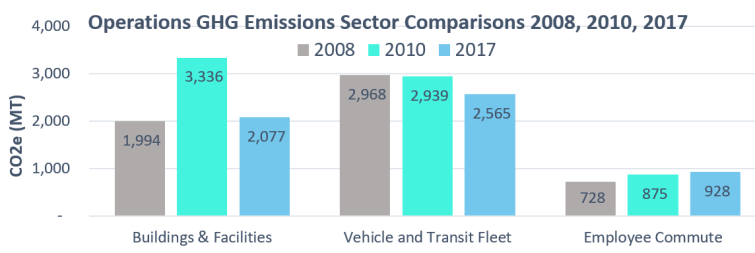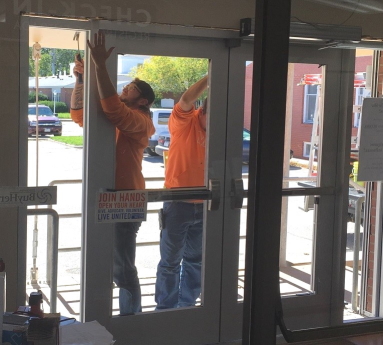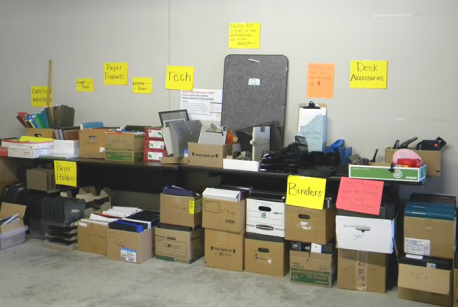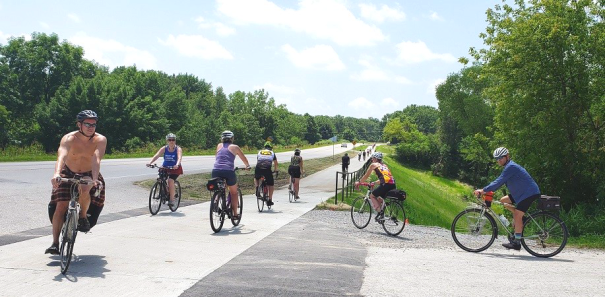Welcome to the Johnson County Sustainability Update 2019
Fiscal Year July 2018 through June 2019. Downloadable, printable version.
The Mehaffey Bridge Road Trail
The Mehaffey Bridge Road Trail extension between Cedar Springs Drive and Coralville Lake was ready by June 2019 for trail users, including pedestrians and recreational and commuter bicyclists alike. Big Rove, a new RAGBRAI training event, soon took advantage of the new connectivity. Nearly 1,500 cyclists pedaled from Iowa City to North Liberty to Solon and back to Iowa City. The County Secondary Roads Department and Conservation Department played a critical roles in the engineering, public input, funding and construction of this extension that is part of the Iowa River Trail. The project was awarded three federal Transportation Alternatives Program grants, which are administered by the Iowa Department of Transportation. The grants totaled nearly $1.26 million, covering approximately half of the entire project cost.
More than One Megawatt of Solar Added to Residences

Johnson County and six local cities partnered with the Midwest Renewable Energy Association (MREA) to launch a solar group buy program for Johnson County and West Branch residents. Nearly 670 residents attended Solar Power Hours to learn about solar and discount pricing from Moxie Solar for their homes. The full savings potential of the program was realized, and 180 households added 1.12 megawatts of solar. It was MREA's largest outcome of all 22 group buy programs they had organized by that time. The renewable energy generated by 1.12 megawatts is equivalent to removing the carbon dioxide produced by more than 250 passenger vehicles driven for one year.
Greenhouse Gas Inventory Completed
A greenhouse gas inventory of County operations for 2017 found that total emissions were slightly below 2008 levels and substantially below 2010 levels, despite an overall increase in building square footage and energy use.

Energy efficiencies and reductions plus onsite solar coupled with utility-based wind energy helped. However, the County still has work to do to reduce emissions by 80% by 2050. The report, which was completed by the Planning, Development and Sustainability Department, will help the County further identify ways to reduce its carbon footprint.
Onsite Solar and LEED Gold for Newest Building
 The Ambulance Service and Medical Examiner Facility receives about 40% of its electrical energy from 69 kW onsite rooftop solar array completed in August 2018 by Eagle Point Solar. The array is the first outright purchase of an onsite solar array for the County. Four other onsite arrays deliver energy to buildings through power purchase agreements.
The Ambulance Service and Medical Examiner Facility receives about 40% of its electrical energy from 69 kW onsite rooftop solar array completed in August 2018 by Eagle Point Solar. The array is the first outright purchase of an onsite solar array for the County. Four other onsite arrays deliver energy to buildings through power purchase agreements.
The solar array contributed to LEED Gold for new construction recognition from the U.S. Green Building Council in February 2019 when the facility became the County's fourth LEED-certified building. It earned other sustainability points for being located on a previously developed site near public transit, use of low-emitting paints, floor coverings, adhesives and sealants, and offering views to the outdoors. Water-efficient in-door fixtures and landscaping, a vegetated roof, and building materials with recycled content further reduce the environmental footprint.
Nonprofits "Green" Their Energy and Fuel Use
The County expended just over $25,000 in grants to help three local nonprofit organizations with energy efficiency and fuel reduction efforts. The Free Medical Clinic added new energy-efficient front doors, with energy cost savings going toward medications for clients. CommUnity Crisis Services (formerly The Crisis Center) added LED outdoor lights to increase safety and save move than $800 a year. Iowa City Compassion purchased a highly fuel-efficient "green" vehicle to help a primary service of providing clients rides to medical and other appointments.

Resource Reuse and Reduction

The County's Surplus Supply Store completed its first full fiscal year as an "in-person" location, after six years of being an online store only. Sixteen different departments and offices made 83 visits to the store, saving not only resources but also money. Social Services, which requires its staff to check the store before submitting purchase requests for supplies, reported a 5% decrease in their supply budget, and an overall 15% decrease over the past three years.
Internal Sustainability and Energy Reinvestment Fund

In Fiscal Year 2019, the fund covered nearly $19,000 in projects: the remaining cost of the solar panels on the Ambulance Service and Medical Examiner Facility (page 3), software for the greenhouse gas inventory (page 2), and new plantings at the Courthouse, reducing the amount of turf grass. Established in 2014 by the Board of Supervisors, the fund includes energy rebated garnered from County projects. In the past fiscal year, $41,343 in rebates were earned. In the past five years, almost $535,000 in rebates have been achieved, and $280,437 spent on energy, stormwater and other sustainability projects.
Produced by the Planning, Development, and Sustainability Department

